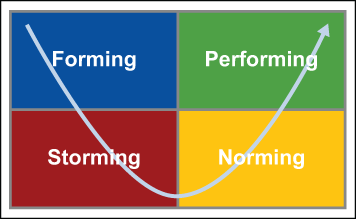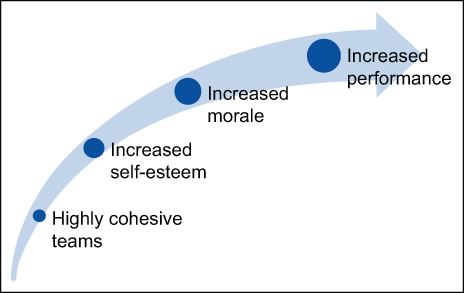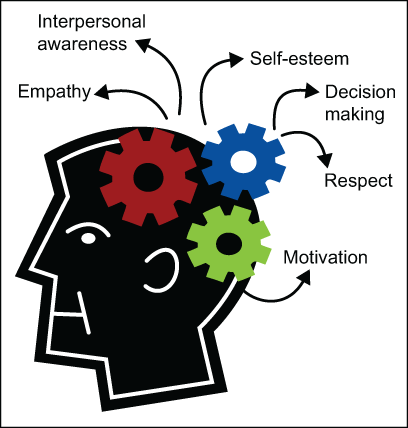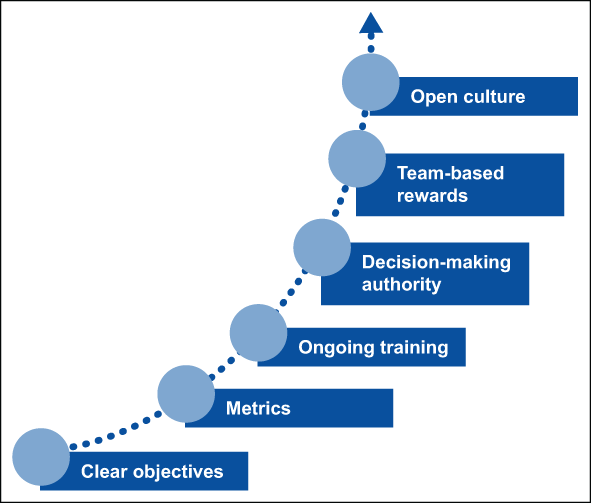
Key Points
- A strong team is formed by following the stages of team development.
- You want to acknowledge your team’s successes.
“There is a desire in each of us to invest in things that matter, and to have the organizations in which we work be successful…Our task is to create organizations we believe in…to be part of creating something we care about so we can endure the sacrifice, risk, and adventure that commitment entails. That’s teamwork motivation.” – organizational development expert Peter Block4
Teams are the basic structure of how projects, activities, and tasks are organized and managed within companies worldwide. Global organizations striving for competitive advantage are increasingly incorporating the use of high-performance teams to deploy complex business strategies.7
Work done in teams provides many advantages and benefits. The major advantages are the diversity of knowledge, ideas, and tools contributed by team members, and the camaraderie among members. A characteristic commonly seen in high-performance teams is cohesiveness, a measure of the attraction of the group to its members (and the resistance to leaving it).
Those in highly cohesive teams will be more cooperative and effective in achieving the goals they set for themselves.9 Lack of cohesion within a team working environment is certain to affect team performance due to unnecessary stress and tension among coworkers. Therefore, cohesion in the workplace could, in the long run, signify the rise or demise of the success of a company.1
Stages of Team Development
Team development takes time and frequently follows recognizable stages as the team journeys from being a group of strangers to becoming a united team with a common goal. According to researcher Bruce Tuckman, in both group dynamics and the four stages of team development he popularized (forming, storming, norming, performing), leaders must retain the motivation of team members to successfully overcome the challenges of the storming and norming stages (Figure 1).

Exploring the Stages
The forming stage represents the beginning, the honeymoon period; great expectations are shared by all team members. Relationships are developed, the purpose is clear and ground rules are established. The storming stage is triggered once team members start jostling for position, stumbling from confusion, and having arguments about leadership, strategy, and goals. This is when team leadership becomes imperative. The leader must succeed at keeping the team motivated, addressing all concerns, and clarifying purpose and goals.
Once the storming stage is overcome the team is ready to establish open communications, stable positions, and norms – the norming phase. Trust is finally gained, and “when the trust account is high, communication is easy, instant, and effective.”5 These are the first steps towards cohesiveness. Once cohesiveness is achieved, teams will move from norming to performing and subsequently to highly performing.
What Is Cohesiveness?
Cohesiveness is the extent to which team members stick together and remain united in the pursuit of a common goal. A team is said to be in a state of cohesion when its members possess bonds linking them to one another and the team as a whole.
Members of a highly cohesive team focus on the process, not the person; they respect everyone on the team, assuming good motives; and they fully commit to team decisions and strategies, creating accountability among the team. Morale is also higher in cohesive teams because of increased team member communication, friendly team environment, loyalty, and team member contribution in the decision-making process.6
Successful business strategies are usually carried out by an effective team with a high level of team cohesiveness. Highly cohesive teams are more committed to the goals and activities, are happy when the team succeeds, and feel part of something significant, all of which increases self-esteem which in turn increases performance (Figure 2).

The Importance of Teamwork
Performance is only as strong as the weakest member of your team. As such, striving for a high-performance team is a great way to guarantee notable performance gains. This isn’t an instant process, however, but one that takes time and effort to foster.
Key Drivers to Achieve Team Cohesiveness
High-performance teams are what make companies successful. Whether the task is to create an innovative product or service or to design a new process or system, teams rather than individuals are assuming more of the load than ever before. The ideal team combines individual talents and skills into one super-performing whole with capabilities that surpass those of even its most talented members.
High-functioning teams are not the result of coincidence. They achieve greater levels of participation and collaboration because their members trust one another, share a strong sense of team identity, and have confidence in their abilities and effectiveness. Such teams possess high levels of team emotional intelligence (EI).10

EI is generally defined as encompassing the awareness and understanding of emotions (Figure 3). It incorporates the application of this understanding to decision-making, regulation, and self-management: these three are all important aspects of teamwork. Studies have shown that EI has a positive impact on teamwork by making the team more cohesive.2
Building an emotionally intelligent team requires developing emotional competence for the group as a whole. Teams that enjoy high levels of EI have established norms that strengthen trust, group identity, and efficiency. As a result, their members cooperate more fully with one another and join forces more creatively in furthering the team’s work.7
Research from organizational behavior experts Vanessa Druskat and Stephen B. Wolff suggests the following three practices to build your team’s EI:
1. Make Time for Team Members to Appreciate Each Other’s Skills.
Interpersonal empathy is critical to confidence. Interpersonal empathy builds confidence within team members; once team confidence is achieved, individual confidence will then follow. The team must be aware of each member’s skills and personality.
People on teams in which they knew one another better were more efficient and got more work done. When team members know the individuals they are working with, they attain a different level of trust with each other. Trust increases motivation and motivation increases commitment; once the two exist within a team you have achieved cohesiveness, which in turn increases performance.
Team-building activities are a great way to implement this EI-building practice. For example, when a team is formed at one company, organize several team-building activities – even outside of normal work hours and location – so that the team members get to know each other better and develop empathy.
Planning meetings outside of the workplace builds camaraderie. Team-building activities also reinforce organizational commitment as the team perceives that the company cares about the success of the team as a whole. Games are a way to engage team members and learn about each other’s skills on a more personal level.
2. Raise and Manage Emotional Concerns That Can Help or Encumber the Team’s Progress.
It is important to establish comfortable, team-endorsed ways to express the unavoidable anger, tension, and frustration that arise in a team effort and to positively redirect that energy. Both humor and playfulness can be helpful tools in resolving conflict and relieving tension and stress.
A couple of examples come from two well-known companies.
- At innovation consultancy IDEO, team members tossed soft toys over cubicle walls when feelings ran high. Besides lightening the mood, this action served as a reminder that the group had established norms for expressing difficult emotions, thereby making them feel less threatening to individuals and to the group as a whole.7
- In another approach, Xerox team members wrote down their gripes, clipped them to play money in denominations from $1 to $100 depending on how serious they felt the issue to be, and dropped them into an “opportunities” jar.
3. Celebrate Success.
Building the EI of a team also requires the expression of positive emotions such as gratitude and admiration when exceeding expectations. Recognizing individual and team achievements not only fortifies a team’s identity, but it also spotlights its effectiveness and collective passion for excellence.
Team lunches after a good project has been completed is an example of a typical celebration. The whole team goes out to a restaurant to celebrate their success and hard work. Another example is featuring a team’s accomplishment in a monthly newsletter from the CEO, so the entire company learns what has been accomplished.
Above and Beyond Cohesiveness
Although cohesiveness is a crucial and determinant factor for team effectiveness, cohesiveness alone will not guarantee success without organizational commitment. Team members can feel cohesion with their teammates but be completely detached from organizational values and vice versa.
Highly effective teams must have both perceived team support (PTS) and perceived organizational support (POS), but their PTS must be higher than their POS. PTS can be defined as the “degree to which employees believe that the team values their contribution and cares for their well-being.” POS can be defined as “the extent to which employees believe that the organization values their contribution and cares about their well-being.”3
Above and beyond cohesiveness other subset factors are important in team development to make teams work, as shown below and in Figure 4:
- A clear set of objectives, communicated explicitly by management
- Metrics allow team members to evaluate their performance and the connection between the work of the team and key business indicators
- Ongoing training
- Decision-making authority necessary to reach business goals
- Team-based rewards and appraisal, not only individual incentives
- An open culture with easy access to relevant information and to senior management as needed

Other Useful Tools and Concepts
Looking for other ways to bolster your teams? Thankfully, you’re in the right place. You might need some additional information on how to handle team capacity planning. Our comprehensive guide is more than covered on the front.
Additionally, if you’re looking for further information on how to take your team’s effectiveness to the very top, we’ve got just the article for you.
Final Thoughts
Teams drive organizational success, though developing and leading high-performance teams is one of the most complex tasks facing any leader in the current competitive work environment. Cohesiveness is the key factor in implementing effective, high-performance teams. Emotional intelligence also plays a key role in building high-performance teams in that emotional intelligence fosters cohesiveness. Managing emotions is how you build a team or an organization.
It is the ability to get team members inspired. Leaders must understand how team cohesiveness works and how bonding in a team will build energy. Leaders must inspire team members by reinforcing a sense of belonging, empathy in bonding, and mutual respect, in addition to giving people choice and power over what they can do. Once that sense of support, that foundation is created, the result is limitless creativity.
References
1. Alvarez, A., Butterfield, L. and Ridgeway, D. “Building Group Cohesion in the Workplace.” Clinical Psychology Associates of North Central Florida Website, http://cpancf.com/articles_files/buildinggroupcohesionintheworkplace.asp, Accessed November 25, 2013.
2. Beam, Myra M., (2012). Emotional Intelligence and Team Cohesiveness. Marshall University. Theses, Dissertations, and Capstones. Abstract.
3. Bishop, J., Scott, K., and Burroughs, S. (2000). “Support, Commitment, and Employee Outcomes in a Team Environment,” Journal of Management, 26(6), 1113-1132.
4. Block, Peter. (1993) Stewardship: Choosing Service Over Self-interest, San Berrett-Koehler, pages 9-10.
5. Covey, Stephen. (1989). The Seven Habits of Highly Effective People, FranklinCovey, pages 50, 51.
6. Daft, R., & Marcic, D. (2009). Understanding Management (6th ed). Mason, Ohio: South-Western Cengage Learning
7. Druskat, V. and Wolff, S (2001). “Building the Emotional Intelligence of Groups,” Harvard Business Review, pages 82, 83 and 85.
8. Lussier, R., and Achua, C., (2010). Leadership: Theory, Application, & Skill Development (4th ed.). Mason, Ohio: South-Western Cengage Learning.
9. Oxford Brookes University, Oxford Centre for Staff and Learning Development, “Characteristics of a Group: Cohesiveness,” http://www.brookes.ac.uk/services/ocsld/resources/small-group/sgt107.html. Accessed November 25, 2013.
10. Ross, Judith A., (2006). “Make Your Good Team Great,” Building Team Trust and Cohesiveness. Harvard Management Update, http://www.beingabetterleader.com/docs/building%20team%20trust%20and%20cohesiveness.pdf?LanguageID=EN-US, Accessed November 25, 2013. 11-12
11. Tuckman, Bruce W. (1965). “Developmental Sequence in Small Groups,” American Psychological Association. Psychological Bulletin, Volume 63, Number 6, Pages 384-99, http://openvce.net/sites/default/files/Tuckman1965DevelopmentalSequence.pdf. Accessed November 25, 2013.